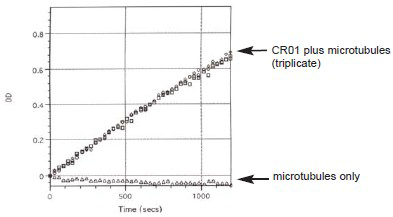Chromokinesin kinesin motor domain protein (KIF4): GST tagged: Homo sapiens recombinant
Product uses
- Measurement of microtubule-activated AT Pase activity
- Identification/characterization of proteins or small molecules that affect motor ATPase activity
- Identification/characterization of proteins or small molecules that affect kinesin motility
- Identification/characterization of proteins or small molecules that affect motor/microtubule interactions
Material
The conserved motor domain of human Chromokinesin (KIF4) was expressed in a prokaryotic system. The recombinant protein contains a GST-Tag at the amino terminal end and has a combined molecular weight of 72 kD. The protein has been determined to be biologically active in a microtubule-activated ATPase activity test. The protein is supplied as a lyophilized powder.
Purity
Protein purity is estimated by scanning densitometry of a coomassie-stained SDS-PAGE gradient gel. Figure 1 shows 10 ug of CR01 protein and purity was determined to be >50%. The total protein in each tube will therefore be approximately 50% greater than the amount shown on the tube. The major contaminant at approximately 30 kD is GST protein. The microtubuleactivated ATPase activity of the Chromokinesin motor is not inhibited by this contaminant.

Figure 1. Chromokinesin Motor Domain protein gel. A 10 ug sample of recombinant Chromokinesin Motor Domain protein (GST-tagged) was separated on a 4-20% SDS-PAGE gradient gel, along with Mark12 molecular weight markers (Invitrogen). The fusion protein runs at 70 kD on the polyacrylamide gradient gel.
Microtubule Activated ATPase Assay
Chromokinesin ATPase activity was measured by monitoring real time free phosphate generation using the Kinesin ELIPA Assay Kit (cat.# BK060). The assay is based upon an absorbance shift (330 nm - 360 nm) that occurs when 2-amino-6-mercapto-7methylpurine ribonucleoside (MESG) is catalytically converted to 2-amino-6-mercapto-7-methylpurine in the presence of inorganic phosphate (Pi). One molecule of Pi will yield one molecule of 2amino-6-mercapto-7-methylpurine in an essentially irreversible reaction. Hence, the absorbance at 360 nm is directly proportional to the amount of Pi generated in the kinesin ATPase reaction. Under the conditions outlined below, the Vmax for Chromokinesin microtubule-activated ATPase activity for this Lot was 400 nmoles ATP generated per minute per mg of CR01 (Figure 2). The ATPase rate for this Lot using a 10 minute endpoint assay (Kinesin ATPase End Point Assay Kit, cat.# BK053) was 100 nmoles ATP per minute per mg of CR01. Both of these values are equal to or above the guaranteed minimum.

Figure 2. Chromokinesin microtubule-activated ATPase activity using the Kinesin ELIPA Assay Kit (Cat.# BK060).
For product Datasheets and MSDSs please click on the PDF links below. For additional information, click on the FAQs tab above or contact our Technical Support department at tservice@cytoskeleton.com
Question 1: What is the minimum concentration this kinesin motor protein can be stored at?
Answer 1: For storage at -70°C, the protein concentration should not be less than 5 mg/ml. Kinesin diluted below 5 mg/ml should not be re-frozen as it will lose activity.
Question 2: What is the most common use of this motor domain protein?
Answer 2: The Chromokinesin motor domain protein is most commonly used in conjunction with microtubules to measure microtubule-mediated Chromokinesin ATPase activity. The ATPase activity can be measured with an endpoint or kinetic assay. Other uses of this motor protein include identification/characterization of proteins or small molecules that affect motor ATPase activity and identification/characterization of proteins or small molecules that affect motor/microtubule interactions.
Coming soon! If you have any questions concerning this product, please contact our Technical Service department at tservice@cytoskeleton.com



